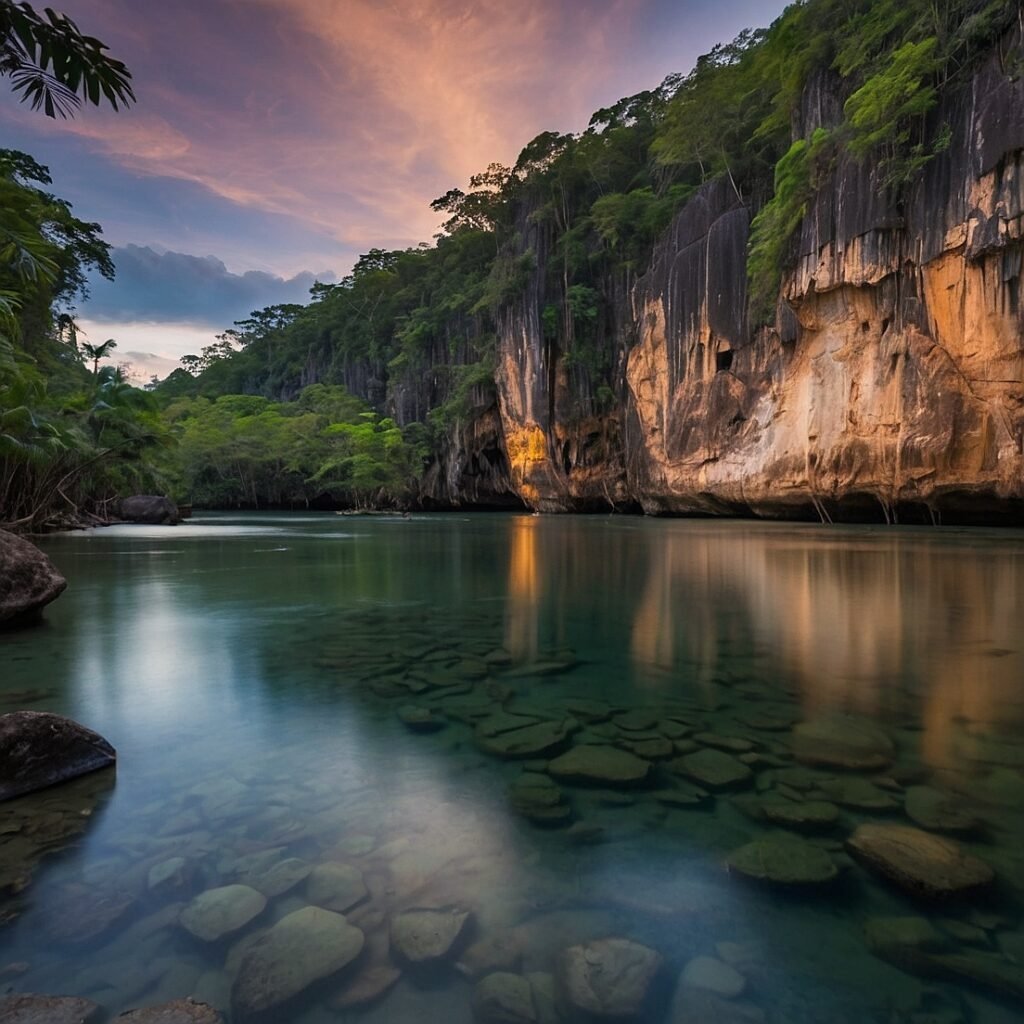The Puerto Princesa Underground River, located in the Philippine island of Palawan, is a natural wonder that captivates visitors with its stunning beauty and unique ecosystem. This subterranean river system, nestled within the Puerto Princesa Subterranean River National Park, holds the distinction of being the world’s longest navigable underground river. Stretching for an impressive 8.2 kilometers, this remarkable geological formation has earned its place as a UNESCO World Heritage Site and one of the New7Wonders of Nature. In this comprehensive exploration, we will delve into the various aspects of the Puerto Princesa Underground River, including its geological formation, biodiversity, cultural significance, and the ongoing efforts to preserve this natural treasure for future generations.
Geological Formation and Characteristics
Origin and Development
The Puerto Princesa Underground River is a testament to the power of geological processes over millions of years. This subterranean river system was formed through a combination of tectonic activity, erosion, and the dissolution of limestone bedrock. The area’s karst landscape, characterized by its soluble rock formations, played a crucial role in shaping the underground river and its surrounding cave system.
The formation of the underground river began approximately 20 million years ago during the Miocene epoch. As the Philippine archipelago emerged from the sea due to tectonic uplift, the limestone bedrock was exposed to weathering and erosion. Over time, rainwater, which is slightly acidic due to dissolved carbon dioxide, began to dissolve the limestone, creating fissures and cavities within the rock.
As these cavities expanded, they eventually connected to form a vast network of underground chambers and passages. The continuous flow of water through these passages further eroded the limestone, sculpting the intricate cave system we see today. The underground river itself is fed by both surface runoff and groundwater, creating a unique ecosystem that supports a diverse array of plant and animal life.
Physical Characteristics
The Puerto Princesa Underground River boasts several remarkable physical features that set it apart from other cave systems around the world:
- Length: The underground portion of the river extends for 8.2 kilometers, making it the longest navigable underground river in the world.
- Depth: The river reaches depths of up to 10 meters in some sections, allowing for boat tours that take visitors deep into the cave system.
- Cave Formations: The cave is adorned with an impressive array of speleothems, including stalactites, stalagmites, flowstones, and draperies.
- Caverns: The river flows through several large chambers, some of which reach heights of up to 60 meters.
- Multiple Levels: The cave system consists of several levels, with the uppermost chambers remaining dry and fossilizing, while the lower levels continue to be shaped by the flowing water.
To better understand the scale and complexity of the Puerto Princesa Underground River, consider the following table comparing it to other notable cave systems around the world:
| Cave System | Location | Total Length | Navigable Underground River Length |
|---|---|---|---|
| Puerto Princesa Underground River | Philippines | 24 km | 8.2 km |
| Son Doong Cave | Vietnam | 9 km | No underground river |
| Mammoth Cave | United States | 651 km | No underground river |
| Clearwater Cave System | Malaysia | 222 km | 5.5 km |
| Xe Bang Fai River Cave | Laos | 7 km | 6.4 km |
As we can see, while other cave systems may be longer overall, the Puerto Princesa Underground River stands out for its extensive navigable underground river, offering visitors a unique opportunity to explore deep into the earth’s crust.
Biodiversity and Ecosystem
Flora and Fauna
The Puerto Princesa Underground River and its surrounding national park are home to an incredibly diverse array of plant and animal species. This rich biodiversity is a result of the unique combination of subterranean and surface ecosystems found within the park.
The forest surrounding the underground river is classified as a tropical moist forest, supporting a wide variety of plant species. Some of the notable flora found in the area include:
- Dipterocarp trees
- Palms
- Rattans
- Orchids
- Ferns
- Mosses and liverworts
The animal life within the park is equally diverse, with numerous species found both above ground and within the cave system itself. Some of the notable fauna include:
- Long-tailed macaques
- Monitor lizards
- Palawan hornbills
- Tabon scrubfowl
- Swiftlets
- Various bat species
- Crustaceans and fish adapted to cave life
To highlight the biodiversity of the Puerto Princesa Underground River National Park, consider the following chart showing the number of species across different taxonomic groups:
Species Diversity in Puerto Princesa Underground River National Park
Mammals |████████████ (30 species)
Birds |████████████████████████████████████ (165 species)
Reptiles |████████ (20 species)
Amphibians |████ (10 species)
Fish |████████ (20 species)
Butterflies |████████████████████ (100 species)
Trees |████████████████████████████████████████ (200 species)
0 20 40 60 80 100 120 140 160 180 200
Number of SpeciesThis chart illustrates the remarkable biodiversity found within the park, with birds and trees being particularly well-represented. It’s important to note that these numbers are constantly being updated as new species are discovered and identified through ongoing research efforts.
Unique Cave Ecosystem
The underground river and its associated cave system support a unique ecosystem adapted to the dark, humid environment. This ecosystem is characterized by several distinct zones, each with its own set of environmental conditions and adapted organisms:
- Entrance Zone: This area receives some sunlight and supports a mix of surface and cave-adapted species.
- Twilight Zone: Limited light penetrates this area, supporting algae and moss growth.
- Dark Zone: Completely devoid of natural light, this zone is home to specially adapted cave-dwelling organisms.
- Transition Zone: This area between the underground river and the sea supports a mix of freshwater and marine life.
Some of the unique adaptations observed in the cave-dwelling organisms include:
- Loss of pigmentation
- Reduced or absent eyes
- Elongated appendages for enhanced sensory perception
- Slower metabolisms to conserve energy in the nutrient-poor environment
The cave ecosystem is largely dependent on organic matter brought in by the river, bats, and birds. This material forms the base of the food web, supporting a variety of decomposers, scavengers, and predators adapted to life in darkness.
Cultural and Historical Significance
Indigenous Peoples and Early Exploration
The Puerto Princesa Underground River and its surrounding area have been known to indigenous peoples for centuries. The Tagbanua and Batak tribes, in particular, have long considered the area sacred and have incorporated it into their spiritual beliefs and practices.
Early exploration of the underground river by non-indigenous people dates back to the early 20th century. In 1937, the American ichthyologist Albert Herre conducted the first scientific expedition to study the cave system and its aquatic life. This expedition marked the beginning of scientific interest in the underground river, paving the way for future research and conservation efforts.
Archaeological Findings
Archaeological excavations in the area surrounding the underground river have yielded important insights into the region’s prehistoric past. Some notable findings include:
- Stone tools dating back to the Late Pleistocene period (approximately 50,000 years ago)
- Pottery fragments from various periods of human occupation
- Human remains, including a skull cap dated to around 9,000 years ago
These discoveries suggest that the area has been inhabited by humans for tens of thousands of years, making it an important site for understanding the prehistoric settlement of Southeast Asia.
Modern Recognition and Tourism
In recent decades, the Puerto Princesa Underground River has gained international recognition for its natural beauty and ecological importance. Some key milestones in its modern history include:
- 1971: The area was declared a National Park by the Philippine government
- 1999: The site was inscribed as a UNESCO World Heritage Site
- 2011: The underground river was provisionally named as one of the New7Wonders of Nature
- 2012: The New7Wonders of Nature status was officially confirmed
Today, the Puerto Princesa Underground River is a major tourist attraction, drawing visitors from around the world. The following table illustrates the growth in visitor numbers over the past decade:
| Year | Number of Visitors |
|---|---|
| 2010 | 150,000 |
| 2012 | 195,000 |
| 2014 | 250,000 |
| 2016 | 320,000 |
| 2018 | 400,000 |
| 2020 | 120,000 (COVID-19 impact) |
| 2022 | 280,000 (recovery phase) |
This data demonstrates the growing popularity of the site, as well as the impact of global events such as the COVID-19 pandemic on tourism numbers.
Conservation and Management
Protected Area Status
The Puerto Princesa Underground River is protected under various national and international designations, ensuring its conservation for future generations. These designations include:
- National Park status (1971)
- UNESCO World Heritage Site (1999)
- Ramsar Wetland of International Importance (2012)
These protections help to regulate activities within the park, limit development, and provide a framework for sustainable management of the area’s natural resources.
Management Strategies
The management of the Puerto Princesa Underground River National Park is overseen by the Puerto Princesa Subterranean River National Park Management Board, in cooperation with local and national government agencies. Key management strategies include:
- Visitor Management: Implementing a permit system and daily visitor caps to minimize human impact on the ecosystem.
- Environmental Monitoring: Regular assessments of water quality, wildlife populations, and cave formations to track the health of the ecosystem.
- Community Engagement: Involving local communities in conservation efforts and sustainable tourism initiatives.
- Research and Education: Supporting scientific studies and providing educational programs for visitors and local schools.
- Waste Management: Implementing strict waste disposal protocols and promoting eco-friendly practices among visitors and staff.
Challenges and Future Outlook
Despite its protected status, the Puerto Princesa Underground River faces several challenges that threaten its long-term conservation:
- Climate Change: Rising sea levels and changing precipitation patterns could alter the delicate balance of the cave ecosystem.
- Tourism Pressure: Increasing visitor numbers may lead to environmental degradation if not properly managed.
- Pollution: Runoff from nearby agricultural and urban areas can impact water quality in the underground river.
- Invasive Species: The introduction of non-native species could disrupt the native ecosystem.
To address these challenges, ongoing efforts are focused on:
- Developing more sustainable tourism practices
- Enhancing monitoring and research programs
- Strengthening collaboration with local communities and stakeholders
- Implementing climate change adaptation strategies
By addressing these challenges proactively, managers hope to ensure the long-term preservation of this unique natural wonder for future generations to explore and appreciate.
Conclusion
The Puerto Princesa Underground River stands as a testament to the wonders of the natural world and the importance of conservation efforts. As the world’s longest navigable underground river, it offers visitors a unique opportunity to explore a subterranean ecosystem unlike any other on Earth. From its fascinating geological history to its rich biodiversity and cultural significance, the underground river continues to captivate scientists, nature enthusiasts, and tourists alike.
As we look to the future, the ongoing conservation and sustainable management of the Puerto Princesa Underground River will be crucial in preserving this natural treasure. By balancing the needs of tourism, scientific research, and environmental protection, we can ensure that this remarkable underground river will continue to inspire and educate generations to come, serving as a powerful reminder of the beauty and complexity of our planet’s natural systems.
Disclaimer: This blog post is based on the most current information available at the time of writing. Given the ongoing nature of scientific research and conservation efforts, some details may be subject to change. We encourage readers to consult official sources and recent scientific publications for the most up-to-date information. If you notice any inaccuracies in this article, please report them so we can promptly make the necessary corrections.




